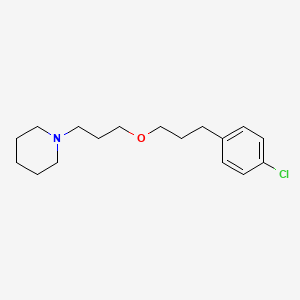Attribution Statement: LactMed is a registered trademark of the U.S. Department of Health and Human Services.
NCBI Bookshelf. A service of the National Library of Medicine, National Institutes of Health.
Drugs and Lactation Database (LactMed®) [Internet]. Bethesda (MD): National Institute of Child Health and Human Development; 2006-.
CASRN: 362665-56-3

Drug Levels and Effects
Summary of Use during Lactation
No information is available on the clinical use of pitolisant during breastfeeding. However, amounts in breastmilk appear to be low and would not be expected to cause any adverse effects in breastfed infants. If pitolisant is required by the mother, it is not a reason to discontinue breastfeeding. Until more safety data are available, pitolisant should be used with careful infant monitoring during breastfeeding.
Drug Levels
Maternal Levels. The manufacturer reports an open-label study in 8 healthy lactating women who were 11 to 96 weeks post-partum. Breastmilk samples were collected over 24 hours after a single dose of 35.6 mg of pitolisant. Pitolisant had a mean peak milk concentration of 47.5 mcg/L with about 50% of the amount of pitolisant measured in breastmilk found during the first 4 hours after the maternal dose. The mean infant dosage of pitolisant was calculated to be 0.009 mg daily, which represented a mean of 0.56% of the maternal weight-adjusted dosage.
Infant Levels. Relevant published information was not found as of the revision date.
Effects in Breastfed Infants
Relevant published information was not found as of the revision date.
Effects on Lactation and Breastmilk
Relevant published information was not found as of the revision date.
Alternate Drugs to Consider
(Narcolepsy) Amphetamine, Armodafinil, Dextroamphetamine, Lisdexamfetamine, Methylphenidate, Modafinil
Substance Identification
Substance Name
Pitolisant
CAS Registry Number
362665-56-3
Drug Class
Breast Feeding
Lactation
Milk, Human
Histamine H3 Antagonists
Wakefulness-Promoting Agents
Disclaimer: Information presented in this database is not meant as a substitute for professional judgment. You should consult your healthcare provider for breastfeeding advice related to your particular situation. The U.S. government does not warrant or assume any liability or responsibility for the accuracy or completeness of the information on this Site.
- User and Medical Advice Disclaimer
- Drugs and Lactation Database (LactMed) - Record Format
- LactMed - Database Creation and Peer Review Process
- Fact Sheet. Drugs and Lactation Database (LactMed)
- Drugs and Lactation Database (LactMed) - Glossary
- LactMed Selected References
- Drugs and Lactation Database (LactMed) - About Dietary Supplements
- Breastfeeding Links
- PubChem SubstanceRelated PubChem Substances
- Review Nefazodone.[Drugs and Lactation Database (...]Review Nefazodone.. Drugs and Lactation Database (LactMed®). 2006
- Review Rimegepant.[Drugs and Lactation Database (...]Review Rimegepant.. Drugs and Lactation Database (LactMed®). 2006
- The histamine H₃-receptor inverse agonist pitolisant improves fear memory in mice.[Behav Brain Res. 2013]The histamine H₃-receptor inverse agonist pitolisant improves fear memory in mice.Brabant C, Charlier Y, Tirelli E. Behav Brain Res. 2013 Apr 15; 243:199-204. Epub 2013 Jan 14.
- Review Solriamfetol.[Drugs and Lactation Database (...]Review Solriamfetol.. Drugs and Lactation Database (LactMed®). 2006
- Review Lumateperone.[Drugs and Lactation Database (...]Review Lumateperone.. Drugs and Lactation Database (LactMed®). 2006
- Pitolisant - Drugs and Lactation Database (LactMed®)Pitolisant - Drugs and Lactation Database (LactMed®)
Your browsing activity is empty.
Activity recording is turned off.
See more...
